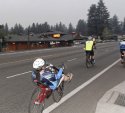Are those the bars that come with the Vendetta? If so I have some at home and I will take another look at them tomorrow. I did try them at one point and saw no problem with using them flipped but wound up preferring the Junebug bar.
When trying to visualize them in 'standard' position vs 'flipped' it is indeed counterintuitive to see them as not changing your shoulder-to-handles distance but it doesn't. Again, i will look at the stock bar again tomorrow when i get home to make sure.
In the meantime part of what makes 'the long answer' long (reallllyyy long) is making sure we're all meaning the same thing when talking about drop bar anatomy. Just like with human anatomy, standardized terms make it possible to know what is meant no matter whether a person is upside down, right side up, sideways, or whatever. 'Adducted', 'abducted', 'anterior', 'posterior', 'medial', 'lateral' etc etc always mean the same thing no matter what. Just like referring to the back of one's hand means the non-palm side even if that side is, at the moment, facing the front.
So, with drop bar anatomy, all terms are based partly on the bar being in the classic diamond frame position. Thus, the tops, or the flats...pretty obvious. The flat, or nearly flat part of the bar, at the top on a standard bike. They're still the tops, or the flats, even if i turn the bar upside down and backwards, so that we all know exactly what part of the bar is being referred to.
The corners....the part where the bar turns forward from the flats. It can make a nearly 90degree turn as with a road bar or a lesser turn as with off-road drops, in which case it is referred to as being flared out. Some off-road drops list degrees of flare in the specs. If the corner turn begins very early the bar can be said to have 'sloped shoulders'.
The ramps....the part that goes forward after the corners and proceeds to the area where the hoods are mounted. The degree of slope of the ramps varies from bar to bar and is sometimes listed in the specs. If the corners are flared, the ramps are flared too.
Reach....the distance from the tops to the hoods, OR to the most forward part of the bar before it curves back towards the rear of the bike. Measurement taken perpendicular to the tops. It is a distance, not a part.
Hooks....the curve where the bar transitions from going forward (the ramps) to going backwards (the drops).
Drops.....the straight part of the bar at the bottom that runs parallel (or nearly so) to the top tube. If it does not run parallel, as with off-road drops, it also is referred to as flared, and degrees of flare are often listed. AKA the handles.
The drop.....another distance. Not a part. The distance from the tops down to the drops.
Ok



. Picky and pedantic, for sure. But reasonably precise and standard.
Why is that useful? Let's answer your question about the boom, and about knee clearance.
"When you flip the bars I'm assuming you would need to extend the boom closer to you (compared to downward facing bars) so that you can reach the handles. Is that correct? Does that interfere with your knees?"
If you keep the shoulder to tops distance the same, your shoulder to handles distance (effective reach) will be constant whether the bar is upside down or right side up, so long as the handles themselves are at the same angle from vertical. Turning the bars upside down doesn't change the drop distance which is the only potential variable in determining your effective reach since your handles were nearly vertical (downward facing) to start with. Now they will become nearly vertical in the other direction, but your drop distance will stay the same. Your ramps will stay the same relative to the tops but pointing down, not up. So you should not need to move the slider.
(Your hands might be higher but not a lot; in fact they won't be any higher than they were if you are one who held on to the hoods at least some of the time. I did that a lot before and liked it; now the bar ends let me put my hands at that height or lower at my pleasure, and with better ergonomics.)
If your bars were set so that the drops/handles were more horizontal to start with, flipping the bars would indeed make a difference in your effective reach and you would need to adjust the slider.
Knee clearance will be unaffected because it is determined by where you set the tops with the slider/boom combo. Since you won't be changing that, if you had no knee clearance problem before, you won't after flipping the bars. True, your hoods will extend below the hooks, which are now the part of your bars closest to the ground, but they won't be much lower than the ends of the drops used to be (especially if you were using bar end mirrors) and in any event are well to the outside of knee/leg motion anyway.
So that's the long (long, long,) answer.
The short answers remain the same: no, no, and no.



Editor's note (and I'm the flippin editor!): I'm at work with nothing much to do at the moment so writing all this out is helping to pass the time. It can get busier than busy in a New York minute but for now it's quiet.
Yes, I'm a little stir-crazy












